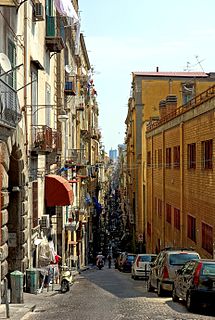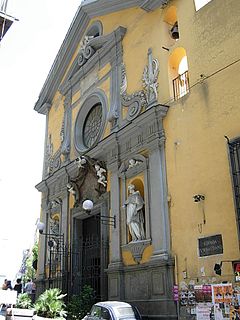
The properties of the Holy See are regulated by the 1929 Lateran Treaty signed with the Kingdom of Italy. Although part of Italian territory, some of them enjoy immunities similar to those of foreign embassies.

Belisario Corenzio was a Greek-Italian painter, active in Venice and Naples. He is one of few Greek painters that did not belong to the Cretan Renaissance like his contemporaries of the time. He escaped the maniera greca completely. He adopted the Venetian style. Other similar Greek painters were Marco Basaiti, Ioannis Permeniates, Antonio Vassilacchi and El Greco. He was sometimes referred to as Il Greco. His teacher was prominent Venetian painter Tintoretto. In 1590, at age 32 Corenzio settled in Naples. Corenzio was influenced by Cavalier d'Arpino. He continued to flourish in the region. His apprentices included: Luigi Rodriguez, Andrea di Leone, Onofrio De Lione and Massimo Stanzione. Corenzio painted many frescos that survived today. Some of his works are in the Church of San Severino and Certosa di San Martino. His style resembles Caravaggio. An Italian legend in Naples exists involving Corenzio, Spanish painter Jusepe de Ribera, and Battistello Caracciolo. They were referred to as the Cabal of Naples. The three painters were rumored to have poisoned their competition for painting contracts. The rumors lack documented evidence. The three painters were very popular in Naples. Corenzio frescoed the Crypt that holds the remains of Matthew the Apostle at Salerno Cathedral and it depicts scenes from the Gospel of Matthew. Corenzio was one of the most celebrated fresco painters in Naples during his time. His drawings can be found all over the world namely at the Metropolitan Museum, Museo di Capodimonte and Louvre.

Trastevere is the 13th rione of Rome: it is identified by the initials R. XIII and it is located within Municipio I. Its name comes from Latin trans Tiberim, literally 'beyond the Tiber'.

Monti is the 1st rione of Rome, identified by the initials R. I, located in Municipio I. The name literally means "mountains" in Italian and comes from the fact that the Esquiline, the Viminal Hills, and parts of the Quirinal and the Caelian Hills belonged to this rione: currently, however, the Esquiline Hill belongs to the rione Esquilino.

Trevi is the 2nd rione of Rome, identified by the initials R. II, located in Municipio I. The origin of its name is not clear, but the most accepted theory is that it comes from the Latin trivium, because there were three streets all leading to the current Piazza dei Crociferi, a square next to the modern Trevi square. Its coat of arms is made of three swords on a red background.

Sant'Eustachio[santeuˈstaːkjo] is the 8th rione of Rome, identified by the initials R. VIII. It is named after the eponymous church and is located within the Municipio I.

Campitelli is the 10th rione of Rome, identified by the initials R. X, and is located in the Municipio I.

There are more than 900 churches in Rome. Most, but not all, of these are Catholic.

Spaccanapoli is the straight and narrow main street that traverses the old, historic center of the city of Naples, Italy. The name is a popular usage and means, literally, "Naples splitter". The name is derived from the fact that it is very long and from above it seems to divide that part of the city.

Via dei Tribunali is a street in the old historic center of Naples, Italy.

Cavour is a station on Line B of the Rome Metro, opened on 10 February 1955. It is located on via Cavour, in the Monti rione of Rome, midway between Santa Maria Maggiore and via dei Fori Imperiali.

In Roman city planning, a decumanus was an east–west-oriented road in a Roman city or castrum. The main decumanus was the Decumanus Maximus, or most often simply the Decumanus. In a military camp this connected the Porta Praetoria to the Porta Decumana.

Santa Maria della Mercede e Sant'Alfonso Maria de' Liguori is a Roman Catholic church located in via San Sebastiano #1 in the historic center of Naples, Italy. It rises on the South-Eastern corner of the intersection of Via San Sebastiano - Via Santa Maria di Constantinopoli, and the Vico San Pietro da Maiella and the outlet of the Via Port'Alba, a narrow alley starting at the medieval gate of Port'Alba. The Vico San Pietro da Maiella feeds into the southernmost end of Via dei Tribunali, corner with via San Sebastiano, and on the Vico, neighboring to the east and behind the church, stands the Conservatory of San Pietro a Majella.

Via della Lungara is a street that links Via di Porta Settimiana to Piazza della Rovere in Rome (Italy), in the Rione Trastevere.

The Piazza Bellini is a plaza located in central Naples, Italy. The Via Santa Maria di Costantinopoli runs along its western side. A block to the south is the Decumanus Maximus.
Naples and its immediate surroundings preserve an archaeological heritage of inestimable value and among the best in the world. For example, the archaeological park of the Phlegraean Fields are directly connected to the centre of Naples through the Cumana railway; also the nearby sites of Pompeii, Herculaneum, Stabiae and Oplontis are among the World Heritage sites of UNESCO.
This page is based on this
Wikipedia article Text is available under the
CC BY-SA 4.0 license; additional terms may apply.
Images, videos and audio are available under their respective licenses.














